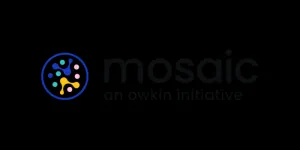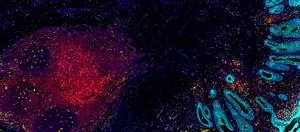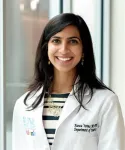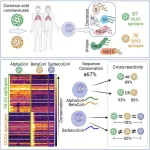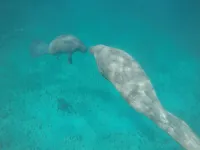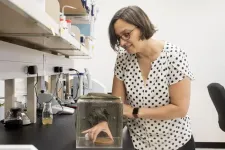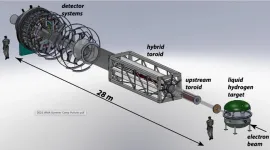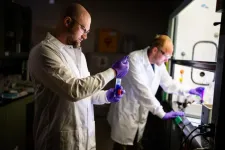– Cutting-edge spatial omics technologies to map cancer cells and their immune environment in high resolution, allowing AI to unlock potential for new breakthrough treatments –
– Landmark research project is 100x larger than existing efforts –
– Data will be generated from thousands of patients across multiple cancers –
– University of Pittsburgh, Gustave Roussy, Lausanne University Hospital, Uniklinikum Erlangen/Friedrich-Alexander-Universität Erlangen-Nürnberg , Charité - Universitätsmedizin Berlin join Owkin, NanoString and other experts in high throughput tissue mapping technologies to discover novel cancer treatments –
Paris and Seattle, June 1, 2023-- Owkin, Nanostring (NASDAQ:NSTG), and world-leading cancer research institutions University of Pittsburgh, Gustave Roussy, Lausanne University Hospital, Uniklinikum Erlangen/Friedrich-Alexander- Universität Erlangen-Nürnberg, and Charité - Universitätsmedizin Berlin are launching MOSAIC (Multi Omic Spatial Atlas In Cancer) at the American Society of Clinical Oncology’s annual meeting (booth #4037). MOSAIC is a landmark $50 million project to revolutionize cancer research through the use of spatial omics, a set of cutting-edge technologies that offer unprecedented information on the structure of tumors.
Spatial omics allows researchers to examine tumors at a near single-cell resolution, while revealing the location and molecular activity of tumor and immune cells. It provides a detailed map of molecular interactions, allowing scientists to decipher key relationships between a tumor and its environment. By generating and analyzing unprecedented amounts of spatial omics data in combination with multimodal patient data and artificial intelligence, MOSAIC aims to unlock the next wave of treatments for some of the most difficult-to-treat cancers.
The first initiative of its kind using spatial omics technology, MOSAIC holds the potential to open a new field in oncology treatment research. Collaborating with Gustave Roussy, the University of Pittsburgh through the UPMC Hillman Cancer Center, Lausanne University Hospital, Uniklinikum Erlangen/Friedrich-Alexander- Universität Erlangen-Nürnberg, Charité - Universitätsmedizin Berlin, NanoString Technologies and other providers of analytical instrumentation and assays for spatial biology, Owkin will invest $50 million to build MOSAIC. It will use 7,000 tumor samples from patients, making it over 100 times larger than any existing spatial omics datasets. Owkin and the MOSAIC partners will mine this resource for immune-oncology disease subtypes in pursuit of biomarkers and novel therapies.
Thomas Clozel, Co-founder, and CEO of Owkin, said:
“The convergence of spatial omics, multimodal patient data, and AI will power the next revolution in oncology research, unlocking the next wave of breakthrough treatments for patients. MOSAIC will help us, and our partners make unprecedented breakthroughs in the fight against cancer.”
Brad Gray, President & CEO of NanoString, said,
“This project holds potential to transform our understanding of cancer biology and spark the development of novel diagnostics and therapeutics. It is an unprecedented collaboration, bringing together NanoString’s powerful spatial biology platforms, the highest quality clinically annotated cancer samples from top cancer research centers, and Owkin’s extraordinary A.I. technology and analytics. “
Robert Ferris, MD, PhD, Associate Vice Chancellor for Cancer Research and Hillman Professor of Oncology at the University of Pittsburgh School of Medicine and Director of UPMC Hillman Cancer Center, said:
“The University of Pittsburgh is excited to be a part of the MOSAIC consortia, which will leverage our UPMC Hillman Cancer Center spatial-omic expertise in understanding cancer cells in their environment. We are enthusiastic to work with other universities and industry partners to uncover actionable insights to detect, treat, and prevent cancer.”
Professor Fabrice André, Director of Research and Professor of Medical Oncology at Gustave Roussy, Paris, said:
“With MOSAIC that combines the most advanced technologies, we are entering a new dimension for the understanding of the mechanism and interaction of tumor cells and their micro-environment. This exciting project will help us discover new therapeutic treatments for patients. Few centers in the world are involved in a project of such magnitude.”
Professor Mauro Oddo, Director of Innovation and Clinical Research at the Lausanne University Hospital, said:
“The MOSAIC project introduces cutting-edge healthcare technology with great potential to advance cancer prediction and treatment. It is also a demonstration of how scientific partnerships between leading academic hospitals and biotech companies are instrumental for successfully translating innovation into improved patient care. It is therefore a great opportunity for the CHUV, in particular through its Biomedical Data Science Center and the Divisions of Medical Oncology and Pathology, to be part of the MOSAIC project.”
Prof. Dr. Arndt Hartmann, Head of the Institute of Pathology of Uniklinikum Erlangen, said:
“The comprehensive characterization of large patient cohorts of cancers with poor prognosis and high medical need for new therapies using spatial omics will provide unprecedented knowledge about tumors and tumor microenvironment. The consortium of large cancer centers with strong commercial partners provides the unique opportunity to detect new treatment options for our patients.”
Prof. Dr. Ulrich Keilholz, Professor of Comprehensive Oncology, Director of Charité Comprehensive Cancer Center, said:
“The Owkin MOSAIC study is a milestone project for us and an exciting opportunity to significantly broaden our single cell multi-omics expertise and achieve an understanding of many cancers at a very detailed level.”
What is spatial omics?
Spatially resolved molecular profiling (also known as spatial omics), recognized as Method of the Year by Nature Methods, is an advanced group of technologies for quantifying and localizing molecular expression that offers scientists an unparalleled view of tumor structures at near single-cell resolution, revealing interactions between tumor and non-tumor cells. By measuring a molecule's expression and mapping it back to its location within the tumor sample, spatial omics allows researchers to 'zoom in' on tumor heterogeneity, cell-cell communication, and tumor-immune system interactions. This innovative approach is set to catalyze unprecedented scientific breakthroughs and transform our fundamental understanding of disease mechanisms.
How will MOSAIC work?
Following the analysis of patient data from research centers using NanoString's spatial omics technology, combined with RNA-seq, proteomics, histology and other medical data, Owkin will develop a data platform and employ its machine learning expertise, including deep neural networks, to uncover novel cancer biology and potential therapies.
MOSAIC will initially focus on multiple cancers with unmet medical needs, including non-small cell lung cancer, triple-negative breast cancer, diffuse large B cell lymphoma, ovarian cancer, glioblastoma, mesothelioma, and bladder cancer. After an initial research period, MOSAIC and its standardized data generation and analysis methods will be made accessible to the global biomedical community, further propelling advancements in oncology research.
What is the significance of MOSAIC?
By utilizing spatial omics technology and AI, MOSAIC enables researchers to examine cancer tumors at nearly single-cell resolution, providing unprecedented insights into the structure, molecular interactions, and cell-to-cell communication within tumors. This detailed information can help scientists better understand complex biological processes and develop more targeted and effective treatments for challenging cancers.
MOSAIC's scale significantly surpasses existing spatial omics studies. Previous efforts are too small by two orders of magnitude to drive breakthroughs. Presently, most studies involving these data modalities are constrained by sample sizes, typically fewer than 50. In contrast, MOSAIC will analyze data from 7,000 patients, enabling scientists to conduct research on data cohorts that are 100 times larger than currently possible.
Who is involved in MOSAIC?
MOSAIC is led by AI biotech company Owkin, providing foundational expertise in artificial intelligence, data science and oncology. NanoString is providing MOSAIC with a world-leading technological foundation for biomarker discovery and translational research, including through the use of NanoString’s GeoMx® Digital Spatial Profiler and CosMx™ Spatial Molecular Imager platforms. Academic research partners will provide their expertise to manage the scientific conduct of the study and conduct research on the MOSAIC data.
About Owkin
Owkin is an AI biotechnology company that uses AI to find the right treatment for every patient. We combine the best of human and artificial intelligence to answer the research questions shared by biopharma and academic researchers. By closing the translational gap between complex biology and new treatments, we bring new diagnostics and drugs to patients sooner.
We use AI to identify new treatments, de-risk and accelerate clinical trials and build diagnostic tools. Using federated learning, a pioneering collaborative AI framework, Owkin enables partners to unlock valuable insights from siloed datasets while protecting patient privacy and securing proprietary data. Owkin was co-founded by Thomas Clozel MD, a former assistant professor in clinical onco-hematology, and Gilles Wainrib, a pioneer in the field of machine learning in biology, in 2016. Owkin has raised over $300 million and became a unicorn through investments from leading biopharma companies (Sanofi and BMS) and venture funds (Fidelity, GV and BPI, among others).
About NanoString Technologies, Inc
NanoString Technologies, a leader in spatial biology, offers an ecosystem of innovative discovery and translational research solutions, empowering our customers to map the universe of biology. The GeoMx® Digital Spatial Profiler, cited in approximately 230 peer-reviewed publications, is a flexible and consistent solution combining the power of whole tissue imaging with gene expression and protein data for spatial whole transcriptomics and proteomics from one FFPE slide. The CosMx™ Spatial Molecular Imager is an FFPE-compatible, single-cell imaging platform powered by spatial multi omics enabling researchers to map single cells in their native environments to extract deep biological insights and novel discoveries from one experiment. The AtoMx™ Spatial Informatics Platform is a cloud-based informatics solution with advanced analytics and global collaboration capabilities, enabling powerful spatial biology insights anytime, anywhere. At the foundation of our research tools is our nCounter® Analysis System, cited in approximately 7,000 peer-reviewed publications, which offers a secure way to easily profile the expression of hundreds of genes, proteins, miRNAs, or copy number variations, simultaneously with high sensitivity and precision.
About Gustave Roussy
Ranked as the leading European Cancer Centre and third in the world, Gustave Roussy is a center with comprehensive expertise and is devoted entirely to patients suffering with cancer. The Institute is a founding member of the Paris-Saclay Cancer Cluster. It is a source of diagnostic and therapeutic advances. It caters for almost 50,000 patients per year and its approach is one that integrates research, patient care and teaching. It is specialized in the treatment of rare cancers and complex tumors and it treats all cancers in patients of any age. Its care is personalized and combines the most advanced medical methods with an appreciation of the patient’s human requirements. In addition to the quality of treatment offered, the physical, psychological and social aspects of the patient’s life are respected. 4,100 professionals work on its two campuses: Villejuif and Chevilly-Larue. Gustave Roussy brings together the skills, which are essential for the highest quality research in oncology: 40% of patients treated are included in clinical trials.
About the Lausanne University Hospital (CHUV)
The CHUV plays a leading role in the fields of medical care, research, teaching, and training, in collaboration with the Faculty of Biology and Medicine at the University of Lausanne (UNIL). Both these institutions are part of the "Health Valley" around Leman Lake. With its mission lying at the crossroads between medicine, sciences, and humanities, CHUV offers a personalized approach to patient care. Several national and international collaborations allow us to deliver the best possible care to our patients.The Division of Medical Oncology within the Department of Oncology UNIL CHUV is the largest in Switzerland with more than 45’000 consultations/year. In addition, the Experimental Therapeutic Center (CTE) runs more than 100 clinical trials. The Department of Oncology is part of the Ludwig Institute for Cancer Research (LICR) and highly active in the field of Immune Oncology and Cellular therapy at the preclinical, translational, and clinical level.Thanks to its role as European reference center in oncology, CHUV is a key partner for MOSAIC, contributing with its broad know-how on biomarkers identification in immunotherapy, tumor microenvironment analysis, and cancer genomics.
About Erlangen
The Institute of Pathology of Uniklinikum Erlangen (UKER) is a high-throughput provider of classical diagnostic pathology and has a broad expertise in conventional surgical pathology, IHC, molecular pathology and digital pathology with 11 specialists, 9 physicians in training and more than 40 additional scientific staff. The expertise is used in diagnostics as well as in research. The MOSAIC UKER PIs, Prof. Dr. Arndt Hartmann, Dr. Markus Eckstein and PD Dr. Ramona Erber, are experts in the field of cancer research with subspecialties in genitourinary pathology, breast pathology, gynaecopathology and immunopathology. Moreover, the Institute of Pathology of Uniklinikum Erlangen is the central pathology institute of several (immune-)oncological clinical trials. Uniklinikum Erlangen is a partner in the Comprehensive Cancer Center Erlangen-EMN and the National Center for Tumor Diseases (NCT WERA).
About Charité - Universitätsmedizin Berlin
The Charité is the medical faculty of the Humboldt University and the Free University of Berlin. With more than 3000 inpatient beds in three full University hospital sites within the city of Berlin, Germany, the Charité is one of the largest University Medical Centers in Europe. In international comparisons, the Charité usually ranks among the top ten global institutions. Key focus areas include oncology, inflammation, cardiovascular diseases, neuroscience, and rare diseases. The Charité Comprehensive Cancer Center (CCCC) is the largest cancer center of Germany and carries the responsibility for seamless interdisciplinary patient care and cancer research of all Charité departments. One focus area is comprehensive precision oncology, encompassing early clinical trials with signal transduction inhibitors and various forms of cancer immunotherapy. The CCCC closely collaborates with Berlin research institutions as well as national and international networks. Among several research areas, a stronghold includes single cell multi-omics technologies and data sciences.
END
